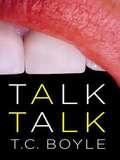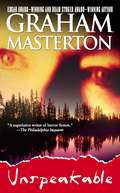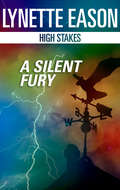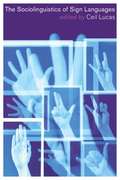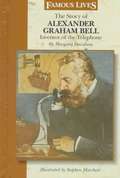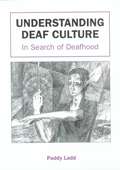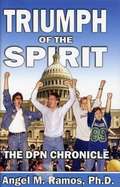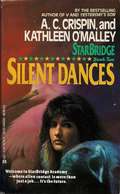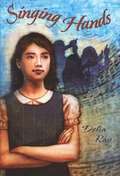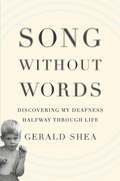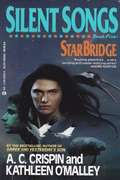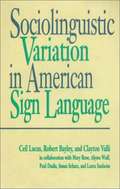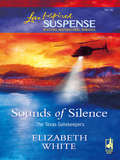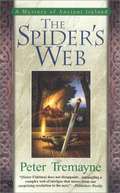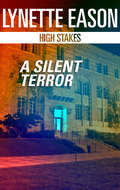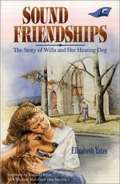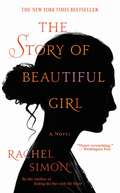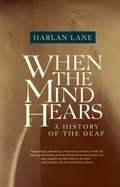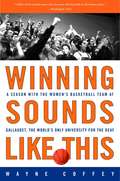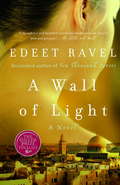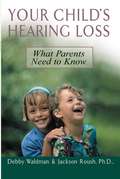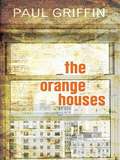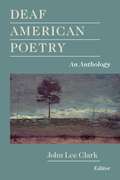Special Collections
Deaf Special Collection
Description: A strong collection featuring biographies, fiction and non-fiction by and about members of the deaf community. For books by and about individuals who are deafblind, visit https://www.bookshare.org/browse/collection/194343 #disability
- Table View
- List View
Talk Talk
by T. C. BoyleOver the past twenty-five years, T.C. Boyle has earned wide acclaim and an enthusiastic following with such adventurous, inimitable novels as The Tortilla Curtain, Drop City, and The Road to Wellville. For his riveting eleventh novel, Boyle offers readers the closest thing to a thriller he has ever written, a tightly scripted page turner about the trials of Dana Halter, a thirty-three-year-old deaf woman whose identity has been stolen. Featuring a woman in the lead role (a Boyle first), Talk Talk is both a suspenseful chase across America and a moving story about language, love, and identity from one of America's most versatile and entertaining novelists.
Unspeakable
by Graham MastertonThere are no words. . .
Holly Summers is deaf, but she "hears" thanks to her immense talent for lip-reading. A child welfare officer, Holly moonlights for the Portland, Oregon, police, using her unique gift to aid in criminal investigations -- including one into the case of a recent string of women who have vanished without a trace. There is no sound. . .
Witnessing unimaginable evil in the abuse cases she handles, Holly fights every day to salvage broken young lives. But her good works spark plenty of enemies; someone has targeted this avenging angel with a supernatural vow to harm her. And the terror begins when Holly's young daughter disappears. There are no dreams as dark as the horrors some men do. Fending off the shadows of an unearthly predator and the very real threats facing a woman in a man's world, Holly must listen to her deepest instincts for survival -- to save the one person for whom she is living.
A Silent Fury
by Lynette EasonA classic Lynette Eason story of faith, family and dangerTragedy strikes Palmetto Deaf School--twice. With one student murdered and another missing, it's up to homicide detective Catelyn Clark to find the killer--and probable kidnapper--"fast."
She'll even work with her ex-boyfriend, FBI agent Joseph Santino, to solve the case...while keeping her distance. Relationships between cops never work; her parents taught her that. They also taught her that the only one she can rely on is herself. But when the killer starts targeting Catelyn, it's only by opening her heart to faith--and love--that she can finally bring the silent fury to an end.
The Sociolinguistics of Sign Languages
by Ceil LucasThis is an accessible introduction to the major areas of sociolinguistics as they relate to sign languages and deaf communities. Clearly organized, it brings together a team of leading experts in sign linguistics to survey the field, and covers a wide range of topics including variation, multilingualism, bilingualism, language attitudes, discourse analysis, language policy and planning. Each chapter introduces the key issues in each area of inquiry and provides a comprehensive review of the literature. The book also includes suggestions for further reading and helpful exercises.
The Story of Alexander Graham Bell, Inventor of the Telephone
by Margaret DavidsonA readable, interesting biography of the famous inventor, paying equal attention to his scientific achievements, his personal life, and his lifelong work with the deaf. There are several odd omissions, though, including why Bell adopted the middle name Graham; the spilled-acid aspect of the first telephone message and Bell's demonstration of the telephone before Queen Victoria.
Sociolinguistics and Deaf Communities
by Ceil Lucas and Adam C. SchembriHow do people use sign languages in different situations around the world? How are sign languages distributed globally? What happens when they come in contact with spoken and written languages? These and other questions are explored in this new introduction to the sociolinguistics of sign languages and deaf communities. An international team brings insights and data from a wide range of sign languages, from the USA, Canada, England, Spain, Brazil and Australia. Topics covered include multilingualism in the global deaf community, sociolinguistic variation and change in sign languages, bilingualism and language contact between signed and spoken languages, attitudes towards sign languages, sign language planning and policy, and sign language discourse. Sociolinguistics and Deaf Communities will be welcomed by students of sign language and interpreting, teachers of sign language, and students and academics working in linguistics.
Understanding Deaf Culture
by Paddy LaddThis book presents a 'Traveller's Guide' to Deaf Culture, starting from the premise that Deaf cultures have an important contribution to make to other academic disciplines, and human lives in general. Within and outside Deaf communities, there is a need for an account of the new concept of Deaf culture, which enables readers to assess its place alongside work on other minority cultures and multilingual discourses. The book aims to assess the concepts of culture, on their own terms and in their many guises and to apply these to Deaf communities. The author illustrates the pitfalls which have been created for those communities by the medical concept of 'deafness' and contrasts this with his new concept of "Deafhood", a process by which every Deaf child, family and adult implicitly explains their existence in the world to themselves and each other.
Triumph of the Spirit
by Angel M. RamosIn 1988 the world's only deaf liberal arts university, Gallaudet University in Washington, D.C. was ready for its next president. The Board of Trustees chose a hearing president who knew nothing about deafness. Unrest had been building on campus over this possibility, especially as there were highly qualified Deaf applicants. When the hearing person was selected and announced, the students exploded in protest. The next 7 days were covered by the national and international news media. What happened at Gallaudet had enormous worldwide impact. Since that protest, Deaf people have proudly advanced in all occupations. The DPN Movement has been likened to a civil rights movement for Deaf people. The author, Angel Ramos, PhD., was directly involved in the protest. Note: all spelling errors were in the print text.
Typhon’s Children
by Toni AnzettiTo the new colonists, the teeming, ocean-dominated planet of Typhon seems a wondrous and exotic paradise--until the land erupts with incomprehensible violence, consuming the colony in a fiery hell. Their supplies lost, the survivors find themselves struggling against a world where death wears many guises. But the deadliest menace strikes from within--for every child born on Typhon suffers strange, degenerative mutations. Unless the situation can be reversed, the Typhon colony is doomed. Per Langstaff is a scientist obsessed with the life-and-death mystery, certain that the answer to the colony's survival lies with the virulent planet itself. His staunchest ally, Dilani, is a rebellious young girl born deaf to sound and convention, an orphan as unruly as the oceans themselves. Together these two outcasts, bound by a shared love of the depths, embark on an unforgettable journey that will take them to the utmost reaches of humanity . . . and beyond.
Silent Dances
by A. C. Crispin and Kathleen O'MalleyDeaf since birth, Tesa is the perfect ambassador to the alien Grus, whose sonic cries can shatter human ears. But her mission is harder than it looks. The Grus are not alone on their world. They have deadly enemies, both natural and otherwise. And if Tesa is to save all life on the planet, she will have to make peace with not one alien species but two.
Singing Hands
by Delia RayAs one of three hearing daughters of deaf parents, 12-year-old Gussie Davis is expected to be a proper representative of Saint Jude's Church for the Deaf in Birmingham, Alabama, which is run by her father. So when Gussie starts to hum through signed services in the summer of 1948, Reverend Davis assumes she merely wants to sing out loud and sends her to a regular church downtown. But Gussie's behavior worsens, and she is not allowed to go on a much-anticipated trip; instead, she must help her father at the Alabama School for the Deaf.
Rebelling against the strict rules of the school, Gussie finally confronts the difficulties and prejudices encountered by the deaf community, all while still trying to find her own identity in the worlds of both the hearing and the deaf.
Drawing on firsthand accounts of her mother's own childhood with deaf parents, Delia Ray provides an inside look at the South in the 1940s. Lively humor, unforgettable characters, and meticulous research combine to make this a standout novel that offers keen insight into what it means to be hearing in a deaf world.
Song Without Words
by Gerald SheaMuch has been written about the profoundly deaf, but the lives of the nearly 30 million partially deaf people in the United States today remain hidden. Song without Words tells the astonishing story of a man who, at the age of thirty-four, discovered that he had been deaf since childhood, yet somehow managed to navigate his way through Andover, Yale, and Columbia Law School, and to establish a prestigious international legal career.
Gerald Shea's witty and candid memoir of how he compensated for his deafness--through sheer determination and an amazing ability to translate the melody of vowels. His experience gives fascinating new insight into the nature and significance of language, the meaning of deafness, the fierce controversy between advocates of signing and of oral education, and the longing for full communication that unites us all.
Silent Songs
by A. C. Crispin and Kathleen O'MalleyThe men and women of StarBridge found intelligent life -- and new friends -- across the galaxy... In the skies of Trinity, the birdlike Grus welcomed the deaf human ambassador, Tesa. In the seas of Trinity, the aquatic Singers communicated with the young telepath, Jib. But on the surface of Trinity, a different kind of life form has landed. They are amphibious beings from a distant world. And they are definitely -not- friendly...
Sociolinguistic Variation in American Sign Language
by Ceil Lucas and Robert Bayley and Clayton ValliThis volume provides a complete description of ASL variation. People from varying regions and backgrounds have different ways of saying the same thing. For example, in English some people say "test," while others say "tes'," dropping the final "t. " Noted scholars Ceil Lucas, Robert Bayley, and Clayton Valli led a team of exceptional researchers in applying techniques for analyzing spoken language variation to ASL. Their observations at the phonological, lexical, morphological, and syntactic levels demonstrate that ASL variation correlates with many of the same driving social factors of spoken languages, including age, socioeconomic class, gender, ethnic background, region, and sexual orientation. Internal constraints that mandate variant choices for spoken languages have been compared to ASL as well, with intriguing results.
Sounds of Silence
by Elizabeth WhiteBorder Patrol agent Eli Carmichael knew the deaf child he'd found outside a Mexican orphanage was harboring a dark secret--she was carrying a bloodstained knife and was clearly traumatized. To keep her safe, he turned to trusted neighbor Isabel Valenzuela. A sense of duty had kept Eli close to his fellow agent's widow and her young son over the past year, and now Eli was spending more time with Isabel and the kids, trying to determine exactly what the girl had seen. Under Isabel's gentle care, the child began to open up. But the killers were close by, and determined to silence the girl forever. . . .
The Spider's Web
by Peter TremayneIn the spring of 666 A.D., Sister Fidelma is summoned to the small Irish village of Araglin. An advocate of the Brehon law courts as well as a religieuse, she is to investigate the murder of the local chieftain. While traveling there with her friend Brother Eadulf, a band of brigands attacks the roadside hostel in which they are staying and attempts to burn them out. While Fidelma and Eadulf manage to beat back their attackers, this incident is only the first in a series that troubles them. When they arrive at Araglin, they find out that the chieftain was murdered in the middle of the night, and next to his body, a local deaf-mute man was found holding the bloody knife that killed him.
While everyone else seems convinced that the man's guilt is obvious, sister Fidelma is not so sure. As she investigates, she's convinced that there is something happening in the seemingly quiet town--something that everyone is trying very hard to keep from her. In what may be the most challenging and confusing situation that she has yet faced, Fidelma must somehow uncover the truth behind the chieftain's murderer and find out what is really going on beneath the quiet surface of this rural town.
A Silent Terror
by Lynette EasonRevisit this tale of danger and intrigue from Lynette Eason
When Marianna Santino's roommate is killed, Detective Ethan O'Hara can't fathom the motive. Then he realizes the deaf teacher was the intended target. Marianna must have something the murderer desperately wants. But what? Digging for the truth, the guarded cop tries to learn everything he can about Marianna. Her world. Her family. Her beauty, faith and fierce independence. In spite of himself, Ethan finds that he can't keep his feelings at bay. Soon, he's willing to risk everything--including his heart--to lay the silent terror stalking Marianna to rest.
Sound Friendships
by Elizabeth YatesFrom the book Jacket: Sound Friendships is the story of Willa Macy, who lost her hearing when she was fourteen years old, and Honey, a golden retriever, who helped her to discover a new world of independence and security. It is also a story about Hearing Dogs-their background, training, special abilities, and the unique relationship they develop with their owners in working to surmount the barriers of a physical handicap.
The Story of Beautiful Girl
by Rachel SimonIt is 1968. Lynnie, a young white woman with a developmental disability, and Homan, an African American deaf man, are locked away in an institution, the School for the Incurable and Feebleminded, and have been left to languish, forgotten. Deeply in love, they escape, and find refuge in the farmhouse of Martha, a retired schoolteacher and widow. But the couple is not alone-Lynnie has just given birth to a baby girl. When the authorities catch up to them that same night, Homan escapes into the darkness, and Lynnie is caught. But before she is forced back into the institution, she whispers two words to Martha: "Hide her." And so begins the 40-year epic journey of Lynnie, Homan, Martha, and baby Julia-lives divided by seemingly insurmountable obstacles, yet drawn together by a secret pact and extraordinary love.
When the Mind Hears
by Harlan LaneImpassioned, polemical, at times even virulent, the author shows immense scholarship, powers of historical reconstruction, and deep empathy for the world of the deaf. The unimaginable world of those who have been born deaf is made almost imaginable by Lane's account of their history. The author's passion and directness are delivered through the mouth of one of his subjects, himself deaf, who became an intellectual leader of the deaf community in France and then in America. The story he tells is extraordinary and is perhaps the best illustration of what it means to see the condition and the patient as a whole.
Winning Sounds Like This
by Wayne CoffeyThe Gallaudet women's basketball team has just defeated the number one ranked team in the country, the College of New Jersey. A reporter, not wanting to be insensitive, delicately broaches the obvious question: "How can you play so well despite your hearing impairment?" Nanette Virnig, a forward for Gallaudet, puts him at ease. "We're not hearing impaired," she says. "We're deaf." Winning Sounds Like This is the remarkable story of the nation's most unique and inspiring women's basketball team and its 1999-2000 season. It is a touching chronicle of players who don't hear buzzers or cheers, a coach who has never used a whistle, and a university that is a mecca for deaf culture throughout the world. Author Wayne Coffey offers an intimate and unsparing look at the players' lives on and off the court, their struggles to overcome the mistreatment and misconceptions of the hearing world, and their deeply rooted connection to one another. Interwoven with an overview of the shameful history of education for the deaf, Coffey explores the players' hopes and dreams and introduces us to such unforgettable people as Ronda Jo Miller, a Minnesota farm girl who is the most decorated athlete in school history; Touria Ouahid, a point guard from Morocco who had to overcome the fierce objections of her Muslim culture to pursue basketball and her education; and their relentlessly dedicated coach, Kitty Baldridge, who has led the Gallaudet women's team for nearly twenty-five years. On the bench for every game, on the bus for every trip, even living in the dorms and attending classes, Coffey presents sensitively crafted portraits of ten remarkable women who adamantly reject the notion that they are disabled in any way. Their goal in life is not to be able to hear, but simply to be accepted and respected. Nearly fifteen years ago, I. King Jordan, Gallaudet's president and a towering figure in contemporary deaf history, issued a famous quote: "Deaf people can do everything but hear." Much more than just a basketball story, Winning Sounds Like This is a celebration of community, of perseverance, and of young women who live out King Jordan's words every day of their lives.
A Wall of Light
by Edeet Ravel"I am Sonya Vronsky, professor of mathematics at Tel Aviv University, and this is the story of a day in late August. On this remarkable day I kissed a student, pursued a lover, found my father, and left my brother." So begins A Wall of Light, a novel which chronicles a single day in the life of Sonya, a thirty-two-year-old deaf woman about to break out of her predictable routine.
Sonya lives in Tel Aviv with her protective half-brother, Kostya; their household has dwindled from five to two. Anna, their mother, is now in a nursing home and Noah, Kostya's son, is living in Berlin. Kostya, wracked with guilt for the tragedies that have befallen Sonya, also grapples with the memory of his wife, Iris, a lawyer murdered in the course of a dangerous investigation seventeen years earlier.As we move through Sonya's day, Noah and Anna narrate their stories as well. Noah's journal entries cover the years 1980-1993, and Anna's letters to Andrei, her married lover in Russia, are written in 1957, after Anna has emigrated to Israel to build a new life for herself and her son, Kostya.
While Sonya's story moves rapidly through the events of a single day, Noah and Anna's voices take the reader back in time, filling in the circumstances that have led Sonya to this pivotal moment. We learn that Sonya has already endured two catastrophes. At age twelve, a medical mishap leaves her deaf, and at eighteen, while studying at university in Beersheba, Sonya is assaulted by two hoodlums. Throughout the novel, Sonya's experiences, instigated by both human error and human evil, are echoed by the larger, political violence that haunts modern Israel.
While Noah's and Anna's voices shed light on Sonya's journey, they also provide insights into the political and cultural fabric of Israel from the mid 1950s to the present. Noah's journal entries, starting with his tenth birthday and ending shortly after his army service, map his coming of age. We see him wrestling with his sexual identity and first sexual encounters, the fallout from his mother's leftist politics, and his own conscription to the army. Anna's secret letters to Andrei offer an outsider's perspective on the new Israeli state.
The remarkable events of Sonya's day are set in motion when her brother gives her an antihistamine. Overcome with sleepiness, she dismisses her morning class early, asking only one student, Matar, to stay behind. She wants to understand what lies behind his unusual expression. He answers that he has been involved in war crimes, and surprises Sonya by kissing her. Sonya feels that she has been roused from a long slumber and as the novel progresses we see the ways in which her awakened desire shapes her choices. She decides to take a taxi home from the university and impulsively invites the taxi driver inside and seduces him. He complies, but when she tells him she's deaf, he flees in confusion. Sonya is convinced that she has fallen in love with him, and decides to pursue him. She solicits her brother's help and sets out to find her lover.
Sonya's search gains in intensity and purpose as she travels to East Jerusalem. There she encounters the walls that prevent Palestinians from moving freely through the West Bank. After an Alice in Wonderland-like journey past numerous obstacles, Sonya finally makes it to her lover's house. This second encounter leads Sonya to a central revelation: the identity of her father.As this day of awakened desire and dispelled secrets closes, Sonya is able to step out from under the protective wing of her brother into a life that reflects both the ambiguity and uncertainty of contemporary Israel and her own personal possibilities.
Your Child's Hearing Loss
by Debby Waldman and Jackson RoushFrom a mother whose daughter has hearing loss, and an audiologist with more than twenty-five years of experience with deaf and hard-of-hearing children and their families, this comprehensive volume offers parents what they need to know from day-to-day practical solutions to technical information to emotional support.
The Orange Houses
by Paul GriffinTamika Sykes, AKA Mik, is hearing impaired and way too smart for her West Bronx high school. She copes by reading lips and selling homework answers, and looks forward to the time each day when she can be alone in her room drawing. She's a tough girl who mostly keeps to herself and can shut anyone out with the click of her hearing aid. But then she meets Fatima, a teenage refugee who sells newspapers, and Jimmi, a homeless vet who is shunned by the rest of the community, and her life takes an unexpected turn.
Deaf American Poetry
by John Lee Clark“The Deaf poet is no oxymoron,” declares editor John Lee Clark in his introduction to Deaf American Poetry: An Anthology. The 95 poems by 35 Deaf American poets in this volume more than confirm his point. From James Nack’s early metered narrative poem “The Minstrel Boy” to the free association of Kristi Merriweather’s contemporary “It Was His Movin’ Hands Be Tellin’ Me,” these Deaf poets display mastery of all forms prevalent during the past two centuries. Beyond that, E. Lynn Jacobowitz’s “In Memoriam: Stephen Michael Ryan” exemplifies a form unique to Deaf American poets, the transliteration of verse originally created in American Sign Language.
This anthology showcases for the first time the best works of Deaf poets throughout the nation’s history — John R. Burnet, Laura C. Redden, George M. Teegarden, Agatha Tiegel Hanson, Loy E. Golladay, Robert F. Panara, Mervin D. Garretson, Clayton Valli, Willy Conley, Raymond Luczak, Christopher Jon Heuer, Pamela Wright-Meinhardt, and many others. Each of their poems reflects the sensibilities of their times, and the progression of their work marks the changes that deaf Americans have witnessed through the years. In “The Mute’s Lament,” John Carlin mourns the wonderful things that he cannot hear, and looks forward to heaven where “replete with purest joys/My ears shall be unsealed, and I shall hear.” In sharp contrast, Mary Toles Peet, who benefitted from being taught by Deaf teachers, wrote “Thoughts on Music” with an entirely different attitude. She concludes her account of the purported beauty of music with the realization that “the music of my inward ear/Brings joy far more intense.”
Clark tracks these subtle shifts in awareness through telling, brief biographies of each poet. By doing so, he reveals in Deaf American Poetry how “the work of Deaf poets serves as a prism through which Deaf people can know themselves better and through which the rest of the world can see life in a new light.”
